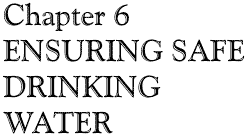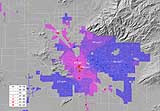
| ch. 6, pp. 82 - 83 |
Salinity Concerns
Although the EPA does not consider TDS to be a health issue, TDS is of concern for several reasons. Some level of TDS is desirable in drinking water and gives it a pleasant taste, but as levels increase beyond 500 mg/l many people complain of the taste. For this reason, EPA has set a secondary (voluntary) drinking water standard for TDS of 500 mg/l. Experience in Tucson and other communities show that as TDS increases, people take action to avoid unpleasant effects. They may buy bottled water, water softeners or home treatment systems, such as charcoal filters or reverse osmosis systems to improve water taste. Saline water supplies can corrode and shorten the useful lives of water-using appliances such as water heaters, water faucets, dishwashers, clothes washers, evaporative coolers, garbage disposals and toilet flush mechanisms. The useful lives of these appliances and fixtures shorten as TDS levels increase. High salinity also can cause deterioration of water pipes over time. Damage can result from increased corrosion of metals that come in contact with the water and from scaling of contacted surfaces. Pipe damage resulting from salinity occurs mostly in steel or iron pipes. Damage can occur both in water mains and in domestic piping. Analysis of corroded pipe samples and interviews with Tucson Water staff after the introduction of CAP water in Tucson indicated that the most troublesome pipe was poor quality galvanized steel pipe that lost its protective zinc coating. This left the steel underneath subject to corrosion. Galvanized steel, copper and plastic (PVC or polybutylene) pipe make up a large majority of the pipe used in Tucson households. Approximately 25 percent of pipe used in Tucson area homes is estimated to be galvanized steel. Tucson water mains are mostly asbestos cement and galvanized iron. Out of 2,400 miles of Tucson water mains, 220 miles were galvanized steel or othe r steel in 1994. By 1998-99, approximately 140 miles had been replaced. High salinity levels also can reduce crop yields and affect the growth rates of some landscape plants. Soil salinity is controlled by water quality and irrigation practices. For example, water TDS levels between 450 and 2,000 mg/l are considered slightly to moderately saline. Salt tolerance of vegetation varies greatly. The native mesquite, saltbush and some non-native eucalyptus have very high salt tolerance, while the native palo verde and jojoba and the non-native pomegranate and lantana have only moderate salt tolerance. Citrus has low salt tolerance, but bermuda and rye grasses tolerate salts well.
Soluble salts can be removed from plant roots by adding excess water (leaching). CAP water has about 2.5 more TDS than Tucson groundwater, but most of the CAP salinity comes from salts that are benign to plants in the soil-plant environment. Dissolved gypsum and calcium carbonates, found in CAP water, are also common minerals in the semi-desert soils. These minerals quickly precipitate (form a solid) and go out of solution in the soil environment and do not raise the salinity of the soil significantly. Compared to groundwater, salt leaching estimates indicate that five to seven percent additional water may be needed to maintain the same salinity in soils when CAP water is used to water plants. Costs Before Treatment Your water bill reflects the various costs of pumping and delivering water, repayment of bonds to lay pipes and build reservoirs, disinfection, reading meters and sending water bills, conservation education programs and administration. Further, Tucson Water adds a CAP surcharge to cover the costs of bringing in CAP. When it sells water bonds, Tucson Water repays the principal and interest through water rates, not through taxes or the general fund. Other water providers also collect the cost of building their water systems through the water rates. The bill may also show a sewer charge Pima County. Treatment Costs Water treatment is currently a very small part of the water bill, but could become a significant part depending on CAP water treatment choice. Providing specific costs of treatment methods is difficult because emerging technology continues to lower the their costs. For example, the cost of membrane filters is about half what it was just a few years ago. Some generalizations, however, are valid. Adding chlorine is the least expensive treatment method and adds almost nothing to the cost of production, while desalting is the most expensive, especially when the costs of disposing of the brine are included. Tucson Water spent more than $85 million dollars to build the existing Hayden-Udall Water Treatment Plant in Avra Valley. Customers are still paying for the plant in their water bills. If we are to use CAP water, the least costly treatment alternative probably would be to upgrade that facility using the existing ozone-chloramine system plus proper corrosion treatment. Adopting a very different method — e.g., building a new facility or changing the existing facility over to a new system — would be more expensive. Voters probably would have to approve additional bonds for any new facility. Water treatment operating costs include the cost of chemicals, energy, salaries, and repair and maintenance. Chloramines and chlorine use almost no energy, and the cost of the chemicals is low. Ozone is energy intensive, since the ozone is produced on site. Membrane filtration is even more energy intensive since the process uses energy to force water through the membrane. The smaller the pore size, the more energy is required to operate the system. Membranes also must be cleaned out periodically since the pores become clogged, although some systems have a self-cleaning technique, which itself uses energy. Membranes must be replaced as they lose their effectiveness.
|


